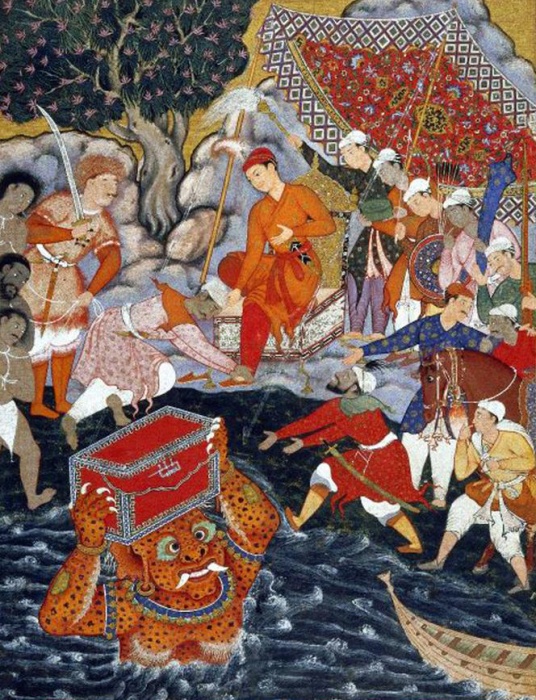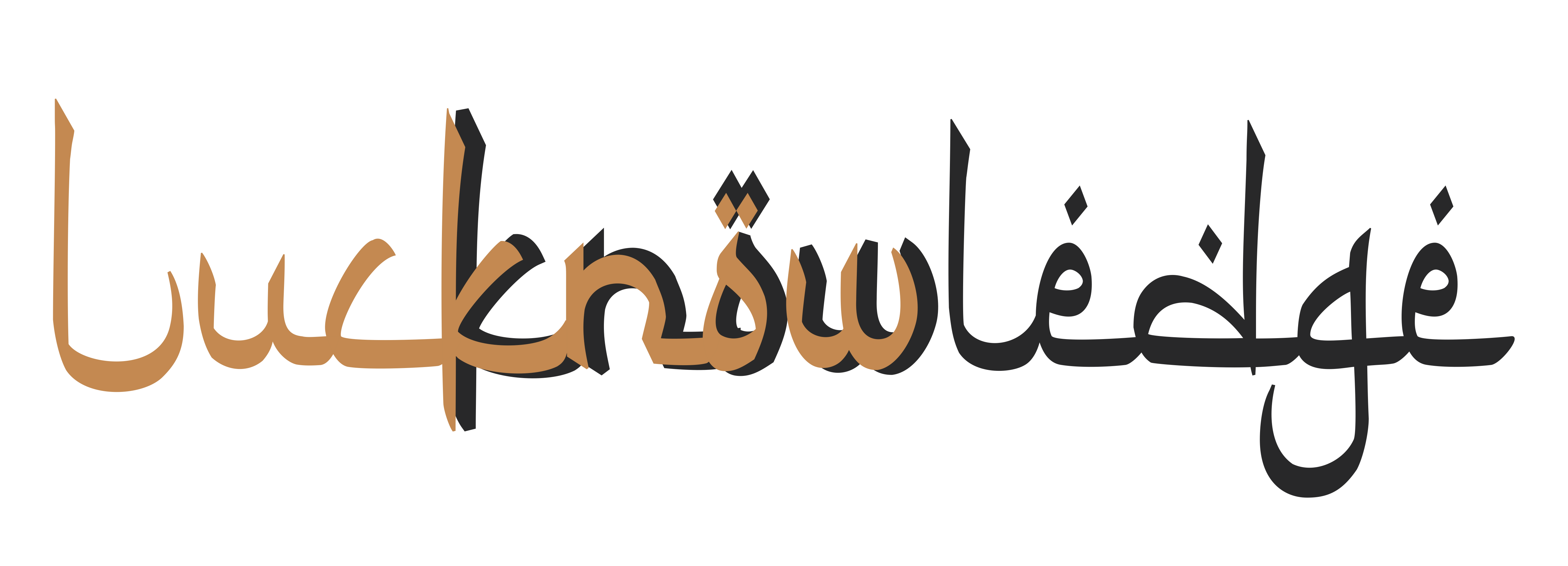Volume: 13, No: 12 ; December-2019
Stories have been told since time immemorial through various forms – and one most enthralling and classic ways are Dastangoi – a 16th-century form of oral storytelling. Dastangoi is not merely telling a story but it’s an art form where the dastango (storyteller) creates a visual in the minds of listeners by his or her powerful oral narration.
The tradition of dastangoi dates back to the times of Mughal Emperor Akbar. During those days, the language used for dastangoi was Persian. In fact, Dastangoi is itself a Persian word – where ‘dastan’ means story and ‘goi’ means to narrate a story. In the 18th century, Dastangoi made its way from Delhi to Lucknow and it was here that it reached its zenith.

Painting – ‘Hamzanama’ by Mughal Emperor Akbar narrating the story of Arghan Dev bringing the armour chest – 1562-1577 (Brooklyn Museum Collection)
Urdu Dastangoi
The development of Urdu language in Lucknow was not only limited to letters and the royal court. Contributions to Urdu were made at all levels of society in Lucknow which refined the language further, broadened it and it assumed new aspects, which were source of interest to all classes. One such effort was Dastangoi, the art of storytelling.
Although Dastangoi originally started in the Persian language, it was Urdu Dastangoi which soon took the center stage and gained popularity. In Urdu literature, dastangoi is often in writing as lengthy tales, called dastans, published in multi volume series. Loose plotlines and verbosity are some of the characteristics of stories called dastans.
Hamid Dabashi, author & professor of Iranian studies and comparative literature at Columbia University states: “what in Urdu called dastan, is a mode of storytelling that combines popular fantasies and literary tropes to produce highly readable and entertaining stories. These stories give an account of heroic deeds … that’s very out-of-the-ordinary, flamboyance places them on the two extremities of legendary lives and thus marks their heroes from mere mortals…”

Munshi Naval Kishore
The Urdu Dastangoi is a priceless heritage. It is suggested that the emergence of Urdu Dastangoi as a tradition took place prominently in Lucknow. And one gem among the Urdu Dastans which were composed in Lucknow was Dastan-i-Amir Hamza ‘The tale of Amir Hamza’. Even though dastans had many principles and many stories, ‘The tale of Amir Hamza’ originally composed by Amir Khusrau was the basis for all other narrations that followed. Similar sorts of stories with imaginative instincts were recited by dastangos of Lucknow in the 19th century. Munshi Naval Kishore took it up for publication in the 1880s and finally 46 volumes of the dastan were published in Lucknow by the Naval Kishore Press. This Dastan is considered as the landmark of Urdu literature. Abdul Halim Sharar, author of ‘Guzishta Lucknow’ regards this art as ‘extemporaneous composition’.
Anatomy of Urdu Dastan
A dastan is made up of four constituents: battle & combat (razm), assembly & entertainment (bazm), enchantment and magic (tilism), and craftiness & knavery (ayyari). The entire dastan is woven around these elements. In Lucknawi dastans, the element of enchantment is given more prominence. Some of the traits of the Lucknow (Urdu) Dastangoi that have been mentioned by literary critics are as follows:
- It mirrors the social conditions of the times. It reflects Indian culture, including customs, modes of dressing and items of food and drinks.
- The narration contains fascinating and astonishing events, including humorous incidents.
- It makes good use of unconventional words and phraseology. Grand presence of characters as well as absorbing and intriguing events.
- A dastan, like that of Amir Hamza, is an extraordinary creative effort in which attempts are made to reach great heights in the use of language and narration.
- The forty-six volumes of the Dastan-i-Amir Hamza are the last grand instance (in the case of Urdu literature) of oral narrative at its pinnacle.
It is believed that this art actually originated in Arabia when in Pagan times assemblies were held for narrating tales. We should not ignore the fact that at the time when Urdu dastans were composed in the 19th century – it was text that held more importance whereas the name of the creator held a little fascination.
The Artists
Dastans were narrated by dastangos – the storytellers. A dastangoi sees everything from a fresh perspective and with a creative fervor. The many incidents narrated in the dastans were gleaned from different places because of the very nature of the dastan and were skillfully amalgamated and integrated to give an ingenious, almost unified structure. Along with the inventiveness, innovation and the resourcefulness of the dastango’s imagination, a good memory is an essential quality of a storyteller.

Mir Baqir Ali, 1850-1928
Among the last of the great dastangos who rose in the middle of the 19th century was Mir Baqir Ali (1850-1928). He narrated and published short humorous tales. His dastans were narrated in dastangoi sessions set up on rooftops in the light of a wick lamp. The audience would often give small donations. Even Mir Baqir Ali used to market his tales in printed form, few of which have survived but many are untraceable now. His volume of work comprises about 21 small books. Some of Mir Baqir Ali’s short tales include:
- Bahadur Shah Ka Maula Bakhsh Hathi (Bahadur Shah’s Maula Baksh Elephant)
- Garhay Khan aur Malmal Jaan ki Jung (the quarrel between Garhay Khan and Malmal Jaan)
- Garhay Khan Ka Dukhra (The sufferings of Garhay Khan)
- Garhay Khan Ki Dhaka-wali se Mulaqat (Garhay Khan’s Encounter with the Woman from Dhaka)
- Garhay Khan Ne Malmal Jaan Ko Talaq Di (Garhay Khan Divorces Malmal Jaan)
Mir Baqir Ali’s compositions are amongst the last remains of the glorious times of Dastangoi in Lucknow and Delhi. What majorly led to a decline of Dastangoi in those times was the new avenues of entertainment such as novels, theatre, and cinema. Also, it is believed that the stories told during dastangois were not in sync with the changing and evolving way of life. This led to the decline of the popularity of dastangoi.
Modern Dastangoi
In Lucknow, the distinctive art of Dastangoi got lost into oblivion after the death of Lucknow’s last Dastango Sheikh Tassaduq Hussain in 1918. However, nearly after century, this art form started getting back its swing, with the rise of modern Dastangos like Late Ankit Chadda (no more now) and Himanshu Bajpai in the city. Himanshu Bajpai is considered as Dastangoi Maestro of modern times. He is often invited to festivals and shows which are being organized around the globe and in the city of Lucknow. Old forms of entertainment are making a comeback because of people like Himanshu, who have made it their mission to revive this art form that was on the verge of extinction. Modern Dastangos entertain the audience with their originality and dwell on contemporary issues like corruption, women empowerment, and communalism. Recently when Tornos celebrated its Silver Jubilee in August 2019, Himanshu enthralled the audience with the story ‘Safar’ set on the life of Tornos’ founder. This was the first such attempt to indicatively bring Dastangoi back in modern times.
The Dastangoi is as much a living tradition in Awadh as any other performing art and even in the times of digital entertainment, it has not completely lost its charm and can still engross the audience with fascinating stories.
LUCKNOWLEDGE is an initiative by Tornos. We do not intend to intrude your privacy and thus have an automated UNSUBSCRIBE system. At any point you may unsubscribe to our e-column or subscribe to it again through a link on our website. The above article is shared and in no way intends to violate any copy right or intellectual rights that always remains with the writer/publisher. This e-column is a platform to share an article/event/update with the netizens and educate them about Destination Lucknow.




